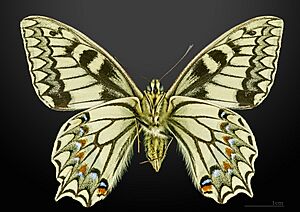Corsican swallowtail facts for kids
Quick facts for kids Corsican swallowtail |
|
|---|---|
 |
|
 |
|
| Conservation status | |
| Scientific classification |
The Corsican swallowtail (scientific name: Papilio hospiton) is a beautiful type of butterfly. It belongs to the Papilionidae family, which includes many large and colorful butterflies. This special butterfly can only be found on two islands in the Mediterranean Sea: Corsica and Sardinia.
Contents
Meet the Corsican Swallowtail!
The Corsican swallowtail is a medium-sized butterfly. Its wingspan is usually between 72 and 76 millimeters. That's about the length of a credit card! It has a striking look with black and yellow colors.
What Does It Look Like?
This butterfly is mostly black with bright yellow markings. It also has pretty blue and red spots on its hindwings. Unlike some other swallowtails, its "tails" (the small extensions on its hindwings) are quite short. Both male and female Corsican swallowtails look very similar.
How Is It Different from Other Butterflies?
The Corsican swallowtail looks a lot like another common butterfly, the Papilio machaon (also known as the Old World swallowtail). However, there are a few ways to tell them apart. The Corsican swallowtail has wings that are more rounded. Also, instead of a long tail, it has a short, tooth-like shape on its hindwing. The black parts of its wings are also usually darker and cover more area than on the P. machaon.
From Egg to Butterfly: Its Life Cycle
The journey from a tiny egg to a flying butterfly is amazing! The caterpillar of the Corsican swallowtail is green. It has black stripes and small yellowish-red dots. The black markings on this caterpillar are more noticeable than on the P. machaon caterpillar.
After growing, the caterpillar turns into a chrysalis. This is like a protective case where it transforms into a butterfly. The chrysalis is green. It has small bumps on its body that are more prominent than those on the P. machaon chrysalis.
Where Does It Live and What Does It Eat?
The Corsican swallowtail loves to live in the mountains. You can find it in areas between 400 and 1500 meters above sea level on Corsica and Sardinia. These butterflies need specific plants to lay their eggs on and for their caterpillars to eat. These plants are from the Umbelliferae family.
Some of their favorite food plants include fennel and giant fennel (Ferula communis). They also eat Corsican rue (Ruta corsica) and Peucedanum paniculatum. The Corsican swallowtail usually has two generations of butterflies each year. One group flies in May, and another flies in August.
Protecting This Special Butterfly
Sadly, the Corsican swallowtail is facing some challenges. Its natural home is shrinking because of human activities. Also, some of the plants it needs to survive are disappearing. Another problem is that sometimes too many butterflies are collected by people. These issues are the main threats to this beautiful and unique butterfly. Protecting its habitat and food plants is very important to help it survive.


